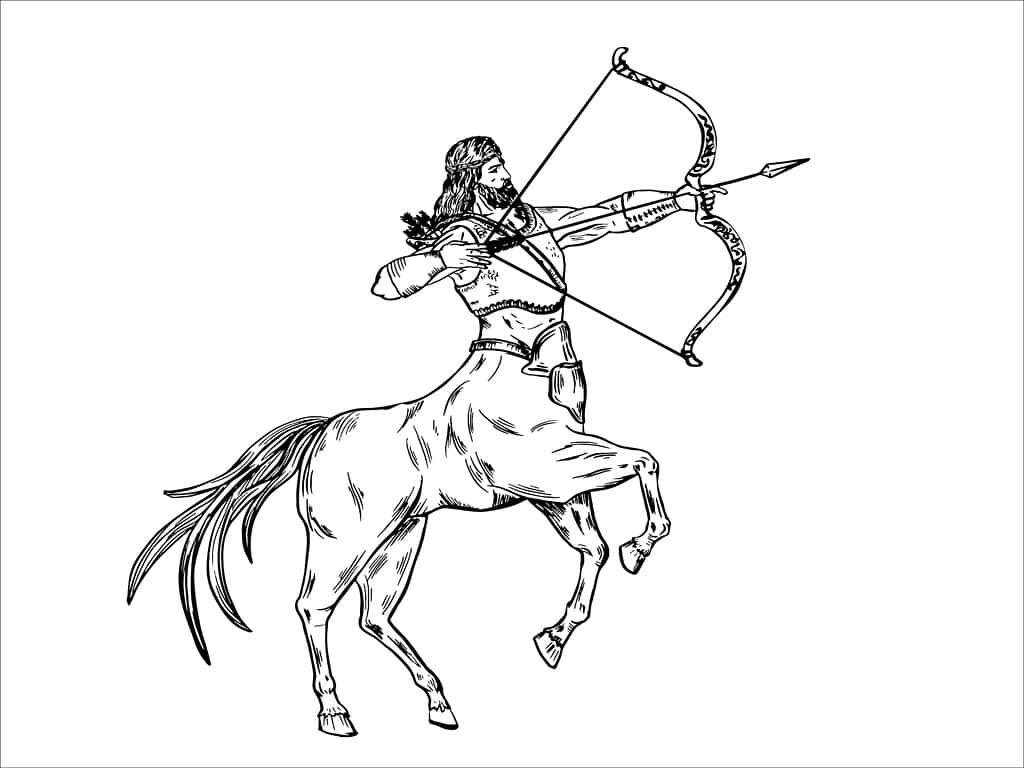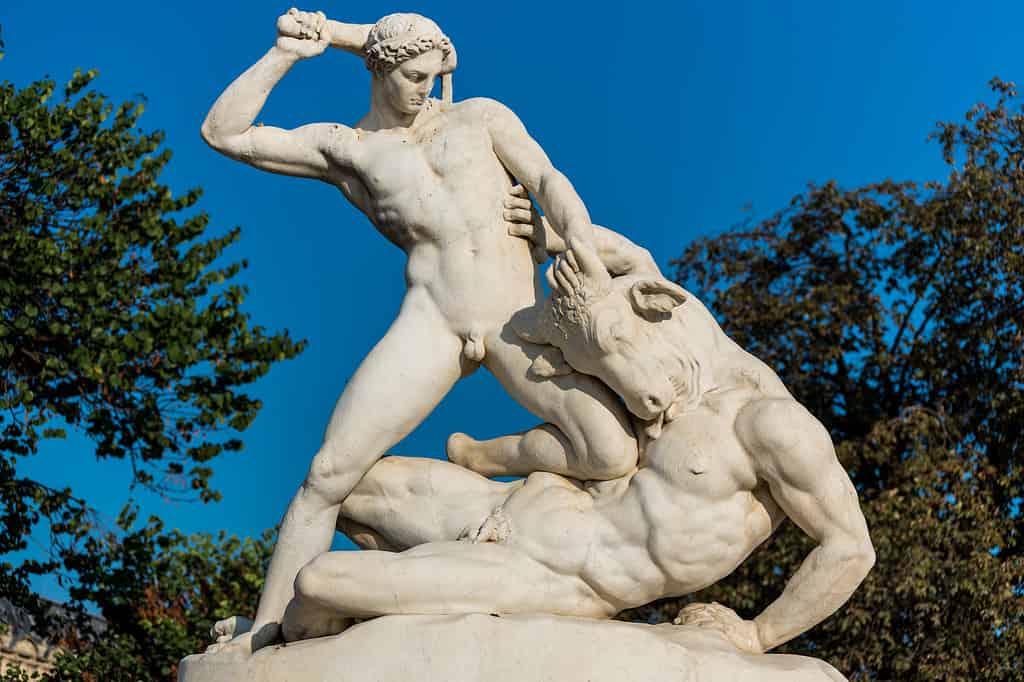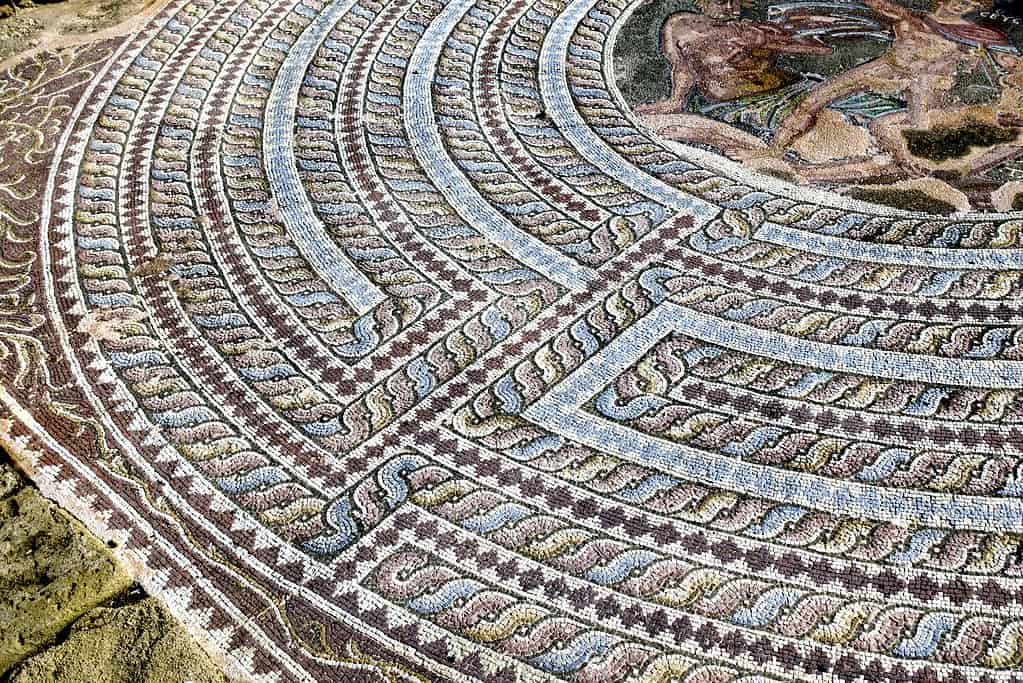Centaurs and minotaurs are well-known creatures of Greek mythology, but what is the difference between the two? Despite their names’ similarities, both creatures differ in their origins and symbolism. However, for as much as they appear to share, they have several differences. Continue reading to learn more about what sets these two ancient creatures apart.
Key Differences
These two mythological beasts are Greek in origin. As half-animal, half-human hybrids, they were both outcasts to society. Otherwise, these two creatures are more different than they are similar.
Centaur

The centaur is most widely recognizable as the zodiac symbol for
Sagittarius
.
©Alesikka/ via Getty Images
The word “centaur” stems from the Greek word Kentauros, which might reference a horse-riding tribe of people in early Greek history. The centaur is depicted as having the torso, arms, and head of a man with the lower half of a horse. Centaurs are a race of creatures residing in the mountains of Thessaly.
Minotaur

The Minotaur is a singular creature according to mythology.
©ZZ3701/ via Getty Images
The origins of the word “minotaur” are a bit more straightforward. Minos comes from Minos, the king of Crete, and tauros (the origin of the star-sign Taurus) is “bull”, which corresponds to the origin story of the beast. The Minotaur has the torso and arms of a man with the legs and head of a bull. Additionally, Minotaur refers to one mythological character, as opposed to an entire race of beings.
Difference in Origins
Centaur
Centaurs have a few differing origin stories. The simplest explanation states that, from a distance, horse riders appeared to the Greeks as half-horse, half-man creatures. However, the mythology behind the birth of the centaur is a bit more colorful.
Some suggest the centaurs came to be through jealousy and deceit. Ixion, the king of the Lapiths of Thessaly (an area of Greece) lusted after Zeus’ wife, Hera. Zeus, attempting to catch Ixion’s desires, sent a cloud disguised as Hera to trick the king. This cloud was actually a cloud nymph called Nephele. Ixion continued his pursuit of Hera (really, Nephele) and the resulting offspring became Centaurus, who then mated with Magnesian mares of Mount Pelion, giving rise to the half-human, half-horse creature called “centaurs”. Some other accounts attribute the hybrid to a slave Dia, who slept with both Ixion and Pegasus, with the resulting offspring featuring traits of both lovers. Some myths suggest different kinds of centaurs result from different origins, but the most widely told story is that of Ixion and Nephele.
Despite their reputation for being a savage and violent race, there were both “good” and “bad” centaurs. One centaur of note is Chiron, a student of the Greek god Apollo. Chiron’s love of nature, science, and the arts revealed the civilized side of this race.
Minotaur
The story of the Minotaur, like many tales in Greek mythology, stems from punishment and insubordination. The king of Crete, Minos, sacrificed a bull to Poseidon and in turn, asked for a replacement bull, which he would use as a second sacrifice. Poseidon’s response was a beautiful, regal white bull that Minos could not bring himself to sacrifice, defeating the purpose of Poseidon’s gift. Instead, Minos sacrificed a “lesser” bull. Poseidon’s rage leads Minos’ wife, Pasiphae, to fall in love with the ethereal white bull. Pasiphae, in the throes of love and lust, enlists the help of Daedalus to create a disguise so she can trick the white bull into mating with her. Her trick is successful, and the offspring of this coupling is the Minotaur.
Disgusted with his wife and her hybrid offspring, King Minos instructs Daedalus to create a labyrinth to trap the Minotaur within. The creature and its labyrinth become a hub for sacrifice. Every nine years a group of seven young men and women are sent to the Minotaur. Eventually, Theseus, an Athenian, put an end to these sacrifices. He went into the labyrinth, slaying the beast after offering himself as a sacrifice. Ariadne, the daughter of Minos, aided Theseus by giving him a weapon and providing him a way out of the labyrinth.
While the Minotaur can be an evil, terrifying figure, some view it as a sad, tragic one. The Minotaur did not choose its path of life. It was born from an ugly desire, leading to its lifelong punishment through no fault of its own. However, as with most stories in mythology, its message is subjective.
How the Myth Relates to Reality
Most stories in Greek mythology carry lessons. The stories of centaurs and the Minotaur are no different in this aspect, though the lessons vary widely.
Even though we don’t face a real race of half-horse, half-man creatures running amok in society, the symbolism behind the centaur is applicable today. While they symbolize barbarism in some sense, the myth is a warning against letting animal instincts take over. Some also extrapolate the myth to symbolize a middle stage between humanity and nature, which must be respected.

Unlike mazes, labyrinths only go in one direction and do not branch.
©vanbeets/ via Getty Images
The Minotaur is symbolic of fear and danger, along with the arrogance and disobedience of man. Whereas the centaur can be a symbol of peace between two entities, the Minotaur is a more tortured soul. Some psychological takes on the myth suggest the labyrinth is a symbol for the unconscious mind, and the Minotaur is representative of our innermost fears and desires. Conquering the labyrinth and the Minotaur of the mind can take repeated efforts of sacrifice, just like in the story.
The photo featured at the top of this post is © iStock.com/Elen11
Thank you for reading! Have some feedback for us? Contact the AZ Animals editorial team.







